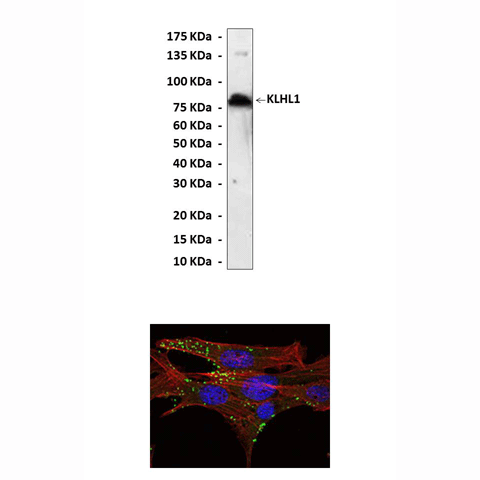Product Sheet CP10269
Description
BACKGROUND The Kelch-related proteins are a superfamily of proteins conserved in a wide range of organisms, from viruses to mammals. At least 60 Kelch-related proteins have been identified, but their physiological and biochemical functions remain largely uncharacterized. Rearrangement of the actin-based cytoskeleton is regulated by a large number of actin-binding proteins. The kelch-related proteins are believed to be important for the maintenance of the ordered cytoskeleton. The Drosophila Kelch proteins colocalize with actin filaments in a structure called the ring canal, which bridges 15 nurse cells and the oocyte. Drosophila Kelch protein plays an important role in maintaining actin organization during the development of ring canals. The Kelch-related proteins have diverse functions in cell morphology, cell organization, and gene expression, and function in multiprotein complexes through contact sites in their β-propeller domains. Recently, a new member of the BTB/Kelch repeat family, gigaxonin, was reported to be a pathological target for neurodegenerative disorders in which alterations were found to contain multiple mutations in the Kelch repeats in the neurofilament network. Alterations and mutations of these proteins were found in brain tumors and neurodegenerative disorders 1
The actin-binding protein Kelch-like 1 (KLHL1) is a neuronal protein that belongs to the evolutionarily-conserved Kelch protein super-family. KLHL1 contains their two signature motifs: a BTB/POZ domain involved in protein-protein interactions, and a Kelch-propeller region involved in actin binding. The mammalian KLHL1 is brain-specific, cytosolic and can form multimers and bind actin filaments. KLHL1\'s function is likely that of an actin-organizing protein, possibly modulating neurite outgrowth, the dynamic morphology of dendritic spine heads; or anchoring proteins essential for post-synaptic function, like ion channels. KLHL1 plays important role in neuronal structure and function. Targeted deletion of the KLHL1 gene in Purkinje neurons results in dendritic deficits in these neurons, abnormal gait, and progressive loss of motor coordination in mice.2 It was shown that KLHL1 regulated neurite outgrowth in a GSK3β-dependent manner.1 In addition, KLHL1 may interact and modulate voltage-gated calcium channels by assessing the interaction of the principal subunit of P/Q-type channels, alpha(1A), with KLHL1.3 In addition, it was shown that KLHL1 is expressed in oligodendrocyte precursors and mature oligodendrocytes (OLGs). (OLGs) are generated by progenitor cells that are committed to differentiating into myelin-forming cells of the central nervous system. Rearrangement of the cytoskeleton leading to the extension of cellular processes is essential for the myelination of axons by OLGs. KLHL1 plays critical role in the dynamics of cytoskeletal rearrangement, leading to the elongation of OLG processes.4
The actin-binding protein Kelch-like 1 (KLHL1) is a neuronal protein that belongs to the evolutionarily-conserved Kelch protein super-family. KLHL1 contains their two signature motifs: a BTB/POZ domain involved in protein-protein interactions, and a Kelch-propeller region involved in actin binding. The mammalian KLHL1 is brain-specific, cytosolic and can form multimers and bind actin filaments. KLHL1\'s function is likely that of an actin-organizing protein, possibly modulating neurite outgrowth, the dynamic morphology of dendritic spine heads; or anchoring proteins essential for post-synaptic function, like ion channels. KLHL1 plays important role in neuronal structure and function. Targeted deletion of the KLHL1 gene in Purkinje neurons results in dendritic deficits in these neurons, abnormal gait, and progressive loss of motor coordination in mice.2 It was shown that KLHL1 regulated neurite outgrowth in a GSK3β-dependent manner.1 In addition, KLHL1 may interact and modulate voltage-gated calcium channels by assessing the interaction of the principal subunit of P/Q-type channels, alpha(1A), with KLHL1.3 In addition, it was shown that KLHL1 is expressed in oligodendrocyte precursors and mature oligodendrocytes (OLGs). (OLGs) are generated by progenitor cells that are committed to differentiating into myelin-forming cells of the central nervous system. Rearrangement of the cytoskeleton leading to the extension of cellular processes is essential for the myelination of axons by OLGs. KLHL1 plays critical role in the dynamics of cytoskeletal rearrangement, leading to the elongation of OLG processes.4
REFERENCES
1. Seng, S. et al: Mol. Cell. Biol. 26:8371-84, 2006
2. He, Y. et al: J Neurosci 26:9975-82, 2006
3. Bomont, P. et al: Nat. Genet. 26:370-4, 2000
4. Jiang, S. et al; J. Biol. Chem. 282:12319-29, 2007
2. He, Y. et al: J Neurosci 26:9975-82, 2006
3. Bomont, P. et al: Nat. Genet. 26:370-4, 2000
4. Jiang, S. et al; J. Biol. Chem. 282:12319-29, 2007
Products are for research use only. They are not intended for human, animal, or diagnostic applications.

(Click to Enlarge) Top: Western Blot detection of recombinant human KLHL1 proteins in lysate from293 cells transfected with human KLHL1 expression vectors using KLHL1 Antibody. Bottom: KLHL1 Antibody specifically reacts with KLHL1 proteins in NIH3T3 cells in confocal immunofluorescent analysis (KLHL1 Antibody: Green; Actin filaments: Red; DRAQ5 DNA dye: blue).
Details
Cat.No.: | CP10269 |
Antigen: | Purified recombinant human KLHL1 fragments expressed in E. coli. |
Isotype: | Mouse IgG1 |
Species & predicted species cross- reactivity ( ): | Human, Mouse, Rat |
Applications & Suggested starting dilutions:* | WB 1:1000 IP n/d IHC n/d ICC 1:50 - 1:200 FACS n/d |
Predicted Molecular Weight of protein: | 82 kDa |
Specificity/Sensitivity: | Detects KLHL1 proteins without cross-reactivity with other related proteins. |
Storage: | Store at -20°C, 4°C for frequent use. Avoid repeated freeze-thaw cycles. |
*Optimal working dilutions must be determined by end user.
Products
| Product | Size | CAT.# | Price | Quantity |
|---|---|---|---|---|
| Mouse KLHL1 Antibody: Mouse KLHL1 Antibody | Size: 100 ul | CAT.#: CP10269 | Price: $413.00 |
